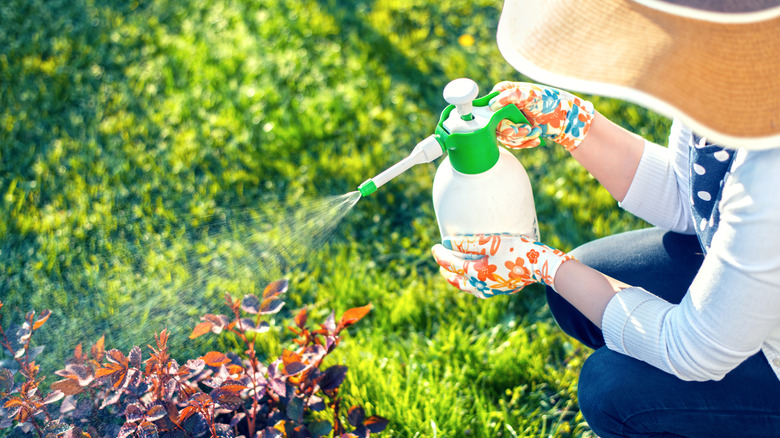The Kitchen Staple That'll Help Naturally Repel Pests From Your Yard
Pantry staples have all kinds of uses outside the kitchen. For instance, you can use vinegar to protect your yard from ground wasps and coffee grounds to repel skunks from your garden. Putting fermented rice water on your plants is another way to prevent pests from infesting your outdoor spaces. It can also deter insects from your houseplants. Instead of using chemical sprays to keep bugs, lizards, and snakes away from your flower garden and vegetable patch, try intimidating these invaders with liquid left over from rinsing or cooking rice. In addition to costing almost nothing, this pest-control method can supply your plants with essential nutrients (similar to vegetable water's benefits for your plants) and bolster microorganisms that help them fight pests.
Fermenting your rice water creates a scent that many pesky critters find unpleasant. Plus, alcohol produced during the fermentation process bothers aphids, flea beetles, fruit flies, and gnats. It may even kill tiny, unwelcome bugs that have dared to touch your plants. To keep this solution from harming beneficial insects or damaging your plants, abide by best practices when making and using it. Doing this can help prevent most problems associated with fermented rice water. These include making soil too stiff, burning plants' leaves, promoting the growth of harmful fungus, and attracting ants and spiders, which like to eat the sugars rice water contains. Preparing and applying it properly is no sweat if you follow a few simple guidelines.
Fermenting rice water and safely applying it to your plants
One method for fermenting rice water starts with soaking white or brown rice. To watch the fermentation process unfold, fill a transparent container with 4 cups of water and add 1 cup of uncooked rice. If you'd like, incorporate a bit of sugar or milk to aid the fermentation process. Cover the container with a towel and let the mixture sit for a couple of days before checking its progress. As the rice begins fermenting, bubbles emerge. Give this foamy process a few days to work its magic before removing the rice and applying the liquid to your plants. Or store the liquid at room temperature until you're ready to use it.
Another fermentation method involves saving liquid from cooking rice. Boil rice in unsalted water for at least 30 minutes, then strain off the liquid and keep it in a covered container for several days before use. Boiling rice releases more nutrients than soaking, so this type of rice water is richer in vitamins and minerals.
Many gardeners filter fermented rice water to prevent pathogens before spritzing it on leaves to deter garden pests. A coffee filter is a handy tool for doing this at home. Also, dilute your rice water so it doesn't burn your plants. The longer you store it, the more dilution it needs. Diluting it with an equal amount of water is common. Introduce rice water in small quantities and note how your plants respond, adjusting the amount or frequency if needed. Gardeners often apply fermented rice water once or twice a month, but your plants may have different preferences.

